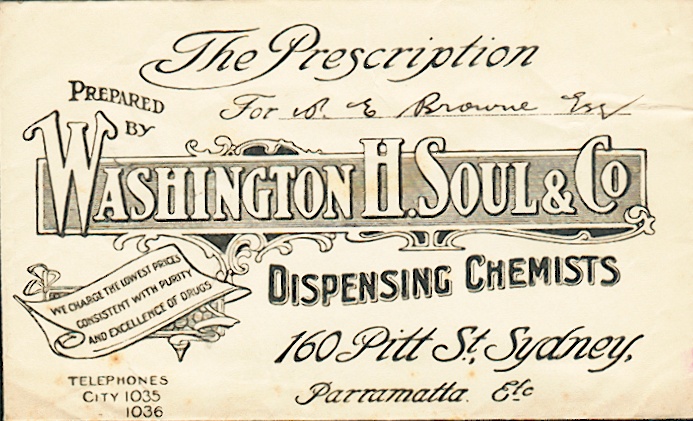This is a double ‘ring-in’ for it has already been partially seen in the Health Sciences paper concerning the large pharmaceutical company of Washington H, Soul & Co. In addition it has never been through the post, but I wish to introduce my ‘alma mater’ hospital Sydney Hospital where I spent 11 years, 4 as a student rather than the usual 3 years, for I was part-time there when I did my B,Sc. (Med) at Sydney University and a further 7 years as a resident, registrar and as the assistant Medical Superintendent. You may remember seeing the following cover in the above-mentioned paper. This will be shown again, now as an itroduction to a senior physican, Dr. Harry John Richie, whom I never met, for he was before my time (Figure 1),

Harold John Ritchie (b. 19.6.1884-d. 9.9.53) a foundation Fellow of The Royal Australasian College of Physicians, was born in Bega NSW on 19 June, 1884. He was educated at Sydney Grammar School and at St Paul’s College. He graduated MB ChM with credits (University of Sydney) in 1908. He then began an association with Sydney Hospital extending over a period of forty years during which he served the Hospital with the utmost distinction as clinician, teacher and administrator. His outstanding intellectual ability was soon recognised and whilst in his senior resident year, he had the unique honour of being appointed honorary assistant physician. He was appointed honorary physician in 1922, and honorary consultant physician upon his retirement from the active staff in 1944.
Dr Ritchie played a major role in the development of the Sydney Hospital Clinical School. He was appointed to the board of medical studies in 1910, and towards the end of the Great War, he and Archie Aspinall were deputed by the medical board to develop a more defined relationship with the University of Sydney and more specifically to obtain equal status with the teachers of the Royal Prince Alfred Hospital. Even then, the relationship between the two hospitals was less than cordial. His son Frank, also FRACP, and senior physician, Sydney Hospital, shared his devotion to the Hospital and was to spend much of his life in a vain attempt to prevent its destruction as a teaching hospital.
In 1921, Harold Ritchie was appointed tutor in clinical medicine, facing the impossible task of teaching physical signs to more than seventy students. He resigned in 1923 and between 1926 and 1944 he was lecturer in clinical medicine. He represented Sydney Hospital on the faculty of medicine for eighteen years. Additional appointments were to Prince Henry Hospital, initially as associate physician and later as consultant, and to the Medical Board of New South Wales. He represented the College on the National Health and Medical Research Council.
With Holmes a’ Court, Ritchie played a major role in the negotiations with the Association of Physicians of Australasia which led to the formation of The Royal Australasian College of Physicians in 1938. He was a foundation Fellow of the College with certificate no.4, councillor 1938-40 and 1948-51, member of the executive committee 1938-51, member of the board of censors 1938-44, vice-president 1940-44, president 1944-46, immediate past president 1946-48, member of the New South Wales state committee 1938-52. He was elected FRCP London, in 1950.
As a physician, Ritchie was a paradigm of his era. Lacking therapeutic tools of any consequence, the consulting physician of those times had only his clinical diagnostic skills, his learning and his authority to offer the patient and the doctor seeking his advice. Reserved but forceful, a courteous, learned gentleman, Ritchie was regarded by his colleagues as a master of clinical medicine and above all as a superb teacher. Though possessing a certain hauteur, which distanced him from people, he possessed the art of communication of all great teachers and of making his students see and feel and hear – he taught informed observation. His tutorials were famous, attracting students from the other teaching hospitals. An unfortunate student would be selected to go through the details of the case with Dr Ritchie, cant and humbug would be ruthlessly exposed and in the end the student and the whole group would be the more honest intellectually for the experience. He and Professor Lambie were a formidable pair to encounter in the professorial viva and woe betide the student who mistook Ritchie’s transient risus as a gesture of familiarity.
He does not appear to have done any research himself but encouraged the development of the Kanematsu Research Institute at Sydney Hospital. The only published paper that can be traced was the Anne MacKenzie Oration – ‘The Interaction of Mind and Body’,(Med J Aus, 1940, 2, 253-5) which reflected his considerable interest in psychosomatic medicine.
The above envelopecontained a prescripton written by Dr. Ritchie for a Mr. Browne which is presented as Figure 2.
A photo of Harold John Ritchie as President of the Royal Australasian College of Physivians is seen as Figure 3.